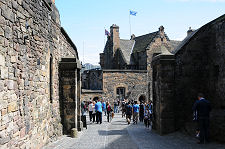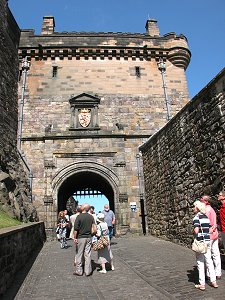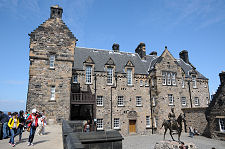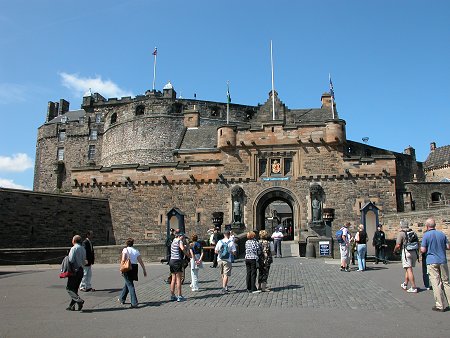 The Main Gate from the Esplanade |
You first really come face to face with Edinburgh Castle on the Esplanade. This area is best known as home to the Royal Edinburgh Military Tattoo each August. From here you progress through the spectacular gatehouse, added in 1888 in a deliberate effort to make the castle more picturesque. Less obvious is a more recent addition on the right as you look at the castle: the entrance to a tunnel built in the 1980s to allow access to the barracks at the west end of the castle.
Inside the outer gate you find the Lower Ward. Ahead of you is the vast bulk of the front wall of the Half Moon Battery, built after the damage caused during the Lang Siege of 1571-3. On your right is the Ticket Office. Your onward path leads upwards past the Old Guard Room, now the main castle shop, to the Portcullis Gate, the main entry to the castle since the repairs after 1573. The upper storey, the Argyle tower, was added in 1887 as part of the Victorian prettification of the castle.
Beyond the Portcullis Gate lies the largest open area within the castle, the Middle Ward. This comprises a broad cobbled road that climbs around to the left. To your immediate left the castle rises steeply to the ramparts of the Upper Ward above you. A shortcut to them is available via the Lang Stairs, once the only way up to the higher levels of the castle.
As you walk round the curve of the Middle Ward you pass the Argyle Battery, the castle's main defence to the north, before reaching the cartsheds built in the 1740s that now house the excellent cafe. Further round you pass the Governor's House and New Barracks on your right, neither of which is open to the public.
But before you get that far, take a look to the right of the cart sheds. Here you find the Mills Mount Battery, from where the One O'Clock Gun is fired every day except Sundays, Good Friday and Christmas Day.
This tradition dates back to 1861 and used to be tied (literally, by electric wire strung across the city) to a visual signal of the time on Calton Hill. It is still possible to see maps printed with a series of rings showing you the exact time at the moment you hear the gun, depending on your distance from the castle.
Close by are the steps leading down via a display about the gun to the Western Defences, the most open and in many ways most pleasant part of the castle, offering wonderful views to the west and a unique perspective of this end of the castle.
Another diversion from the Middle Ward takes you down to the old hospital. This now houses the National War Museum, larger than you could imagine possible from the outside and well worth a visit, even on a nice day when you might prefer to be outside in the sunshine.
Also accessible from the Middle Ward are the smaller museums of the Royal Scots Regiment and the Royal Scots Dragoon Guards.
The upper end of the Middle Ward also gives access to the Military Prison, and to the Castle Vaults. The Vaults are under Crown Square and were once home to hundreds of prisoners of war from the wars with France and America in the second half of the 1700s.
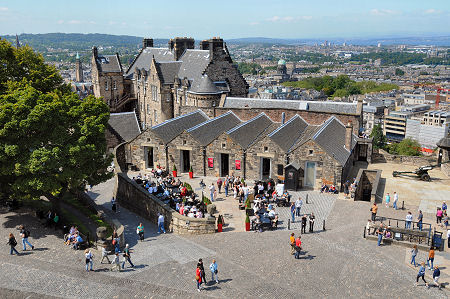 The Middle Ward, with the One O'Clock Gun on the Right |

|
|
|
Visitor InformationView Location on MapEdinburgh Castle Pages: Edinburgh Castle: Main Page and Visitor Information Edinburgh Castle: Upper Castle Edinburgh Castle: Lower Castle What3Words Location: ///mute.divide.policy |
Edinburgh Castle In Fiction
|
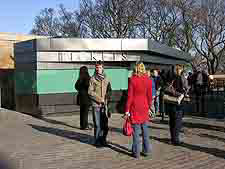 Ticket Office |
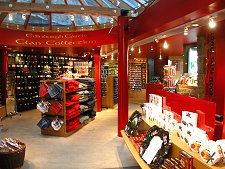 Main Gift Shop |
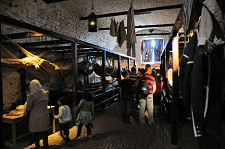 Castle Vaults |
 The Stockholm Run by Ken Lussey (26 May 2022).
The Stockholm Run by Ken Lussey (26 May 2022).